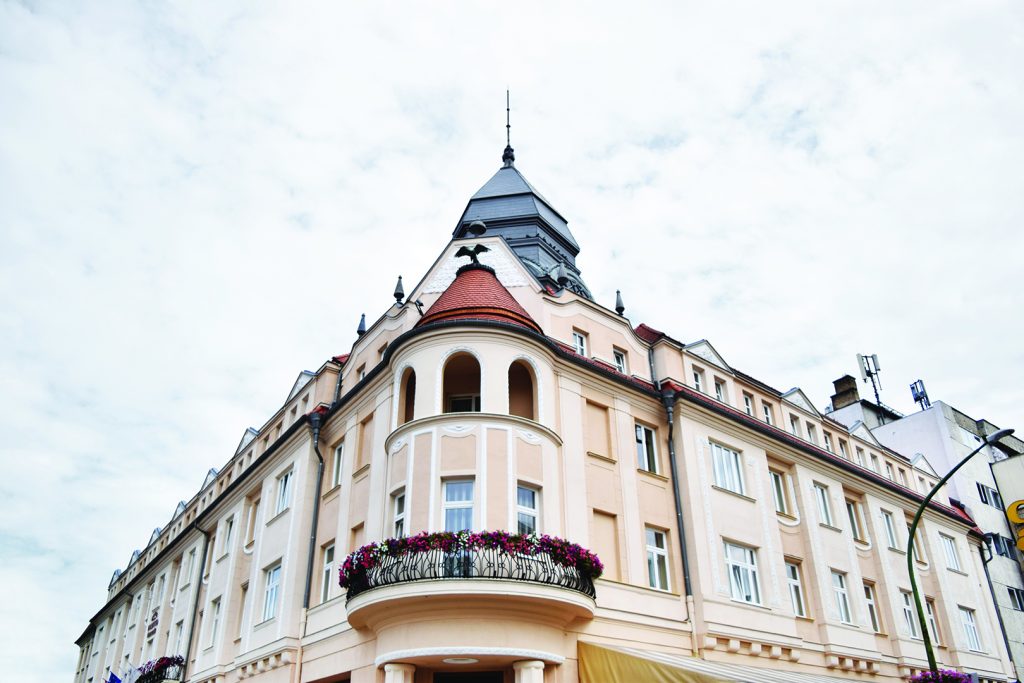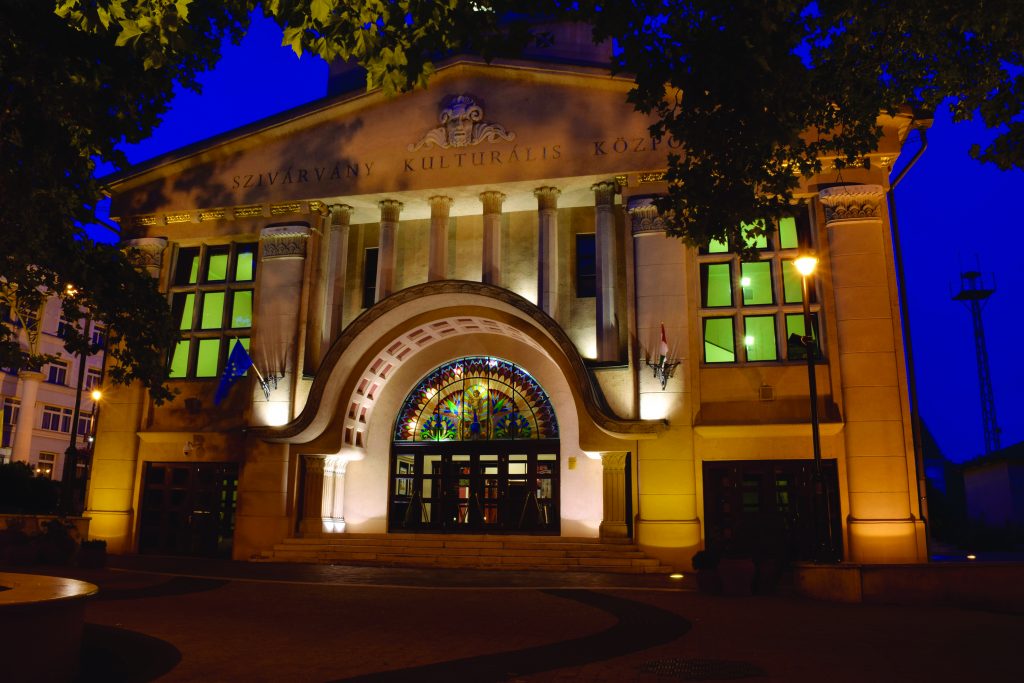More than one of our buildings became symbols through the enthusiasm, work, hope, will and remembrance of our residents – like the weather cottage on Kossuth Square, the charming fountain in Berzsenyi park, the Art Nouveau Style Adam-Eve House in Kontrássy street, the Rippl-Rónai Villa on the Roma Hill or the double cross on Kecelhegy.
Cities endowed with spiritual power through symbols have soul: they have a common past, a liveable present and a future together. If you join us for this walk in Kaposvár, You, dear tourists and you, dear locals will surely spot the numerous pearls washed ashore on the banks of river Kapos…

© Kovács Kristóf
The fortification of Kapos dating from the Middle Ages was completely destroyed during the centuries. The stairway of the Townhall features a period wall painting after a 17th century etching, which depicts the castle after a 131-year Ottoman occupation. It was liberated by the troops of Ludwig von Baden in 1686.

© Pintér Rómeó
Completed by 1904, the Neo-Renaissance Townhall was designed by György Kopeczek and Róbert Kertész. It is not only part of the main architectural heritage of the city, which underwent significant changes at the turn of the 19th -20th century but also a symbol of the locals’ desire for freedom and their commitment to our national independence. The inauguration ceremony took place on 15th March, which, at that time, was still an unofficial anniversary of the 1848 Fight for Freedom and Independence.

© Mágó Armand
The church built in Neo Roman style is the symbol of the local Catholic community’s strength as well the city’s ability to renew and reinvent itself. The current building is the third church standing on the same site, each built bigger and stronger than the one before. Completed in 1886, it marked the 200th anniversary of the liberation of the city from the Turkish occupation.

© Forró Erika
St. John of Nepomuk has been Kaposvár’s patron saint since the 18th century. His Baroque- style statue dates back to 1742 and survived a fire and other misfortunes – the originally unpainted statue was once coloured by an unknown perpetrator under cover of darkness. The second oldest monument of the city has been moved several times over the years till it was re-erected in front of the cathedral.

© Pintér Rómeó
A few steps away you can find the Dorottya House, also called Hotel Csokonai which is one of the oldest buildings of the city. Originally the dwelling house of the bailiff, it was immortalized in poet Csokonai’s comic epic called Dorottya, inspired by an infamous ball in 1798, serving as an inauguration of Count Ferenc Széchenyi’s Lord Lieutenancy. The greatest poet of the Hungarian Enlightenment, Mihály Csokonai Vitéz himself attended the ball and his statue – the work of János Fritz – was unveiled in front of the building in 1977.
The pharmacy called Golden Lion opened in the 1780s in a Baroque-style building in the Main Street. Its walls not only saw the young Rippl-Rónai, but poet Mihály Csokonai Vitéz, who bought medication there to alleviate his toothache.

© Pintér Rómeó
Since the beginning of the new millennium, Kaposvár revives the everyday life of the early 20th century and at the same time evokes the memory of its famous painters – József Rippl-Rónai, János Vaszary and Sándor Galimberti. As of 2013, the colourful cultural festival offering a wealth of events is called Rippl-Rónai festival.
Kaposvár is rightly called a city of schools as the first educational institute was opened as early as 1715, soon after the resettlement. East of the cathedral stands a primary school dating from 1832 which is still operating today and the inscription on the facade reads: “To the nation’s little citizens”.

© Pintér Rómeó
Inaugurated in 1832, the County Hall was designed by Ferenc Török and considered one of the finest examples of the Classicist style. In 1852 emperor Franz Joseph stayed overnight in the impressive building and in 1878 the actress and singer Lujza Blaha, „the Nightingale of the Nation” performed here.

© Pintér Rómeó
The former Erzsébet Hotel was built in 1901 in the main square and was named after the lovely Sissi, wife of the emperor Franz Joseph, who was well-liked by the Hungarians. The Eclectic-style building with its colourful tower is decorated with Zsolnay ceramic roof tiles and hosted another famous lady – actress Lujza Blaha, who stayed here in 1904, during her second tour in Kaposvár.

© Pintér Rómeó
The Art Nouveau building standing on Széchenyi Square – currently called Dorottya House – was designed by Géza Aladár Kármán and Gyula Ullmann. It was opened in 1911 and operated as a hotel, boasting 78 rooms, a cafe, a restaurant, a cardroom, a bowling alley, snooker room and a brasserie. The hotel was named after the Turul, a mythological bird of prey, which is a national symbol of Hungary.

© Pintér Rómeó
Near the railway station, the building of the local theatre was completed in 1911 and has been considered one of the symbols of Kaposvár ever since. One of the biggest, most modern and perhaps the most expensive theatre outside Budapest was designed by Szeged architects Ede Magyar and József Stahl, the construction supervised by Péter Melocco of Budapest. Located in Rákóczi Square, it has operated as a repertory theatre with an ensemble company under the name Gergely Csiky Theatre since 1955.

© Mágó Armand
One of the most remarkable buildings of the pedestrianized Main Street was named after its builder, the Kemény family who were grain merchants. Dating from 1904, the richly ornamented house with beautiful wrought iron pieces is home to the local Tourist Information Office.

© Pintér Rómeó
Number 4 Kontrássy Street is one of the finest buildings of Art Nouveau architecture in Kaposvár. Locally known as „Adam and Eve House”, its façade displays the naked figures of Adam and Eve. The work of young sculptors Imre Borovitz and Imre Csikász was considered „indecent” by some of the early 20th century citizens.

© Pintér Rómeó
The biggest apartment house in Main Street was built by the Somogy County Savings Bank in 1913. No money was spared and this was one of the first buildings equipped with an elevator in Kaposvár. The Art Nouveau-style palace was named Anker House after one of the occupants, Anker Insurance Co. The early 20th century saw more and more financial institutions taking up residence and erecting new buildings in the Main Street as Kaposvár was considered the financial and economic centre of the county. The façades of former banks still retain the original ornaments featuring beehives which were thought to be the symbols of saving.

© Pintér Rómeó
Turning into Ady Street, we can join painter József Rippl-Rónai who is engaged in a chat with poet Endre Ady. This statue by sculptor Katalin Gera captured the meeting of these two artists in November 1909 when the famous poet held a successful recital in the former Korona (currently Kapos) Hotel opposite.

© Pintér Rómeó
The City Cinema, opened in the 1920s, boasts an intriguing past. It was the venue of the screening of the first colour film in Kaposvár and since then the building has hosted various social functions and political events. Today it is a real palace of culture with a fitting name: Rainbow Culture Palace. The statue called Florentin by sculptor Klára Weeber was placed on the limestone bench in front of the former cinema in 2010, when the building was renovated and extended. Florentin is thought to have kept her vow of silence according to her promise so your secrets whispered into her ears are safe with her.

© Pintér Rómeó
Don’t miss the cherry tree blossoming in Temesvár Street if you happen to be in Kaposvár in spring! Walking along the flowering buds in the quiet of the street reminds you that Kaposvár is one of the most liveable cities in Hungary. An interesting fact is that several streets in the neighbourhood were named after Hungarian towns which were taken from Hungary by the Treaty of Trianon.

© Pintér Rómeó